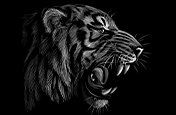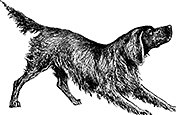How to draw cats.
Graceful and feisty, sneaky and silly. All cats have big personalities, but capturing those
traits in a cute cat drawing can be tricky. Follow this step-by-step drawing tutorial to master the art of sketching felines.
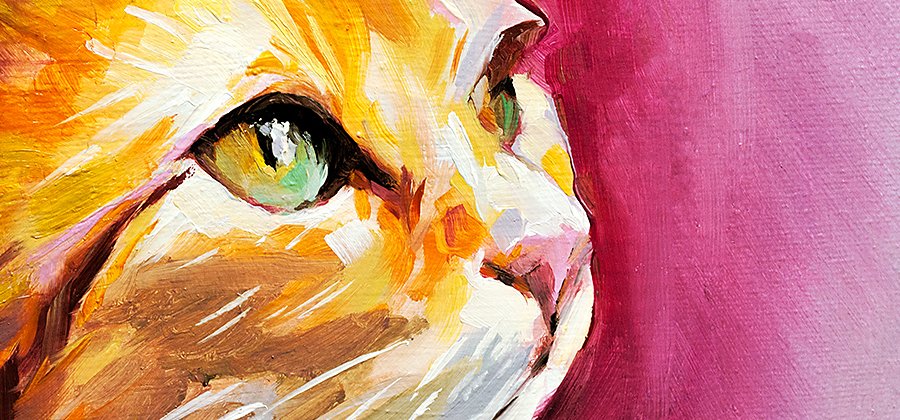
The cat’s out of the bag.
There’s a reason cat videos dominate the internet: people like cats. From their graceful movements to their adorable faces and sassy attitudes, cats make for interesting subjects. Drawing cats can help you improve your artistic skills and give you fun pieces to add to your portfolio. But before you can jump in and sketch a furry kitty, you need to observe the real thing. That’s right, before you draw cats, you need to watch cats.
Take a look at the anatomy of a cat before you start a drawing. Cats’ bodies aren’t proportioned like a dog’s, and their muscle groups are different from those of humans. “One of the important things to study and understand is the skeleton, especially the spine. Cats are very flexible, but they still have limitations. “It’s good to study the muscles and how they sit on the bones,” says illustrator Jade Merien. “You can’t see the muscles, but you're going to need to learn them, because that’s going to dictate how the features and fur look. You need to have an understanding of what’s going on underneath it all.”
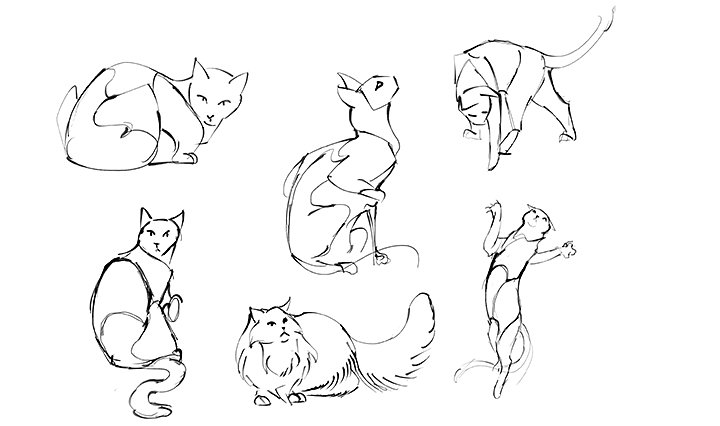
Image by Jade Merien
It’s all about the gestures.
Cats move in ways we don’t always expect. They can stretch incredibly far, curl up into tiny balls, and jump to unexpected heights. Gesture drawings, or quick sketches that capture the movement and pose of your subject, can be a wonderful place to start when drawing cats, whether they’re at rest or in motion. “The most important thing about gesture drawing is getting that line of motion down,” explains Merien. Do a few practice drawings to explore movement and find the cat pose you like best.
Whether they knock a glass off the table or adorably curl up in your lap, cats have character. A great cat drawing will embody that personality and convey it through gesture and facial features. “Cat breeds can look dramatically different from each other,” notes illustrator Ashley Hutchinson. “Persians have funny little smushy faces, and then there’s the British shorthair that’s got a really round head.” Think about how those unique features can help you portray character. A thin, sleek body can help a cat look elegant and poised, while giant ears can make a cat look a little goofy.
Simple steps for cat drawings.
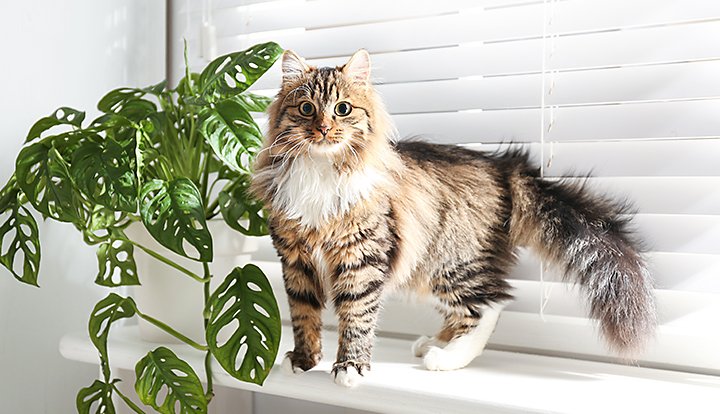
1. Use reference photos.
You may have researched the anatomy of a cat, but you’ll still need to find some good reference photos. This helps you observe and mimic the body shape of a cat, even when it’s foreshortened. If you want to draw a realistic cat, use a photo for reference. But if you want to sketch a cartoon cat, look at art or illustrations to see how other artists have captured feline forms in a stylized way.
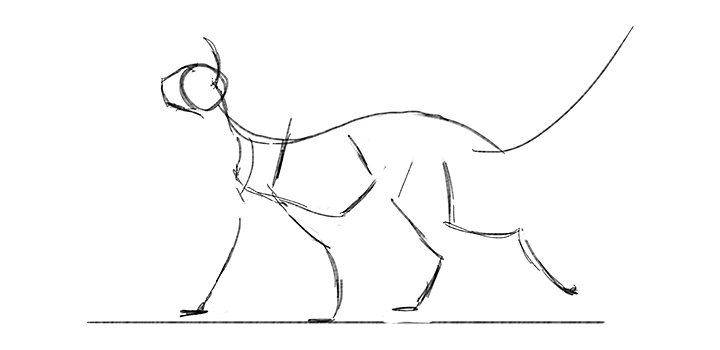
Image by Jade Merien
2. Sketch out the simple shapes.
After you’ve observed the reference images, draw the major shapes of the cat. Start with the cat’s head, and then move on to the body, front legs, hind legs, and tail. “It’s about breaking a subject matter down and building it back up in a meaningful way. And to achieve that, you need to simplify all that chaos,” says Merien. “For a cat, you’re dealing with the fluffy fur and the perspective. So you need to build it back up in a way that your brain can understand.”
When you’ve simplified the cat’s shape, you can get the gesture and positioning right without worrying about the complex details. Be sure to mark where the limbs and joints are, as well as the tail. It’s not just about the individual shapes, it’s also about how those shapes connect to each other.
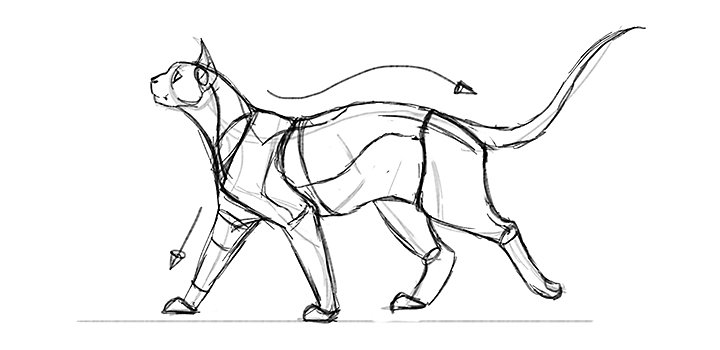
Image by Jade Merien
3. Finalize your line art.
When your basic shapes are done, you can refine the lines into a clear, simple cat shape. “Cats’ ears usually stand up, and they’re normally kind of triangle-shaped. The muzzle is a diamond shape, and their paws are usually kind of small. And cats aren’t very muscular, so they’re kind of soft-bodied,” notes Hutchinson. If you work with digital tools, like Adobe Fresco, create your line art on a separate layer from your gesture drawing or underdrawing. This lets you keep that layer untouched, in case you want to start over.
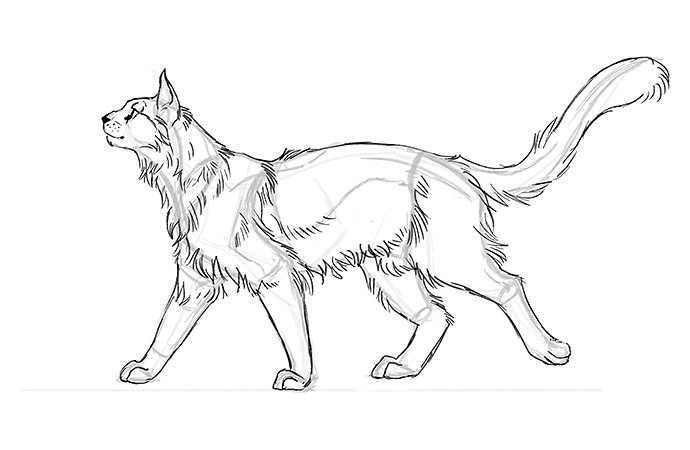
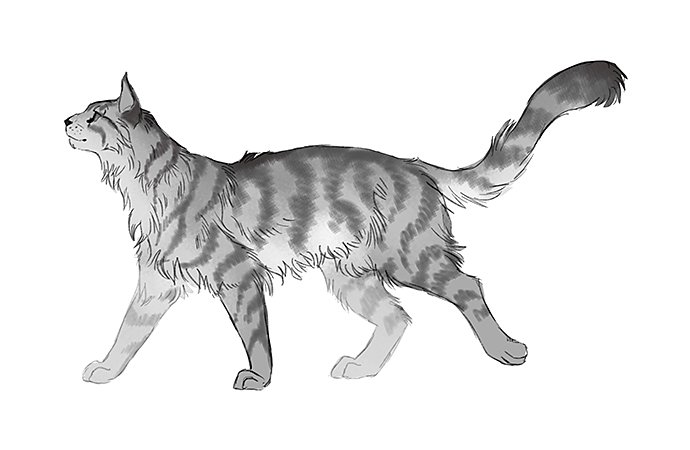
Image by Jade Merien
4. Add detail and color.
Now’s the time to add some polish to your drawing. Finalize the facial details, like the cat’s eyes, whiskers, and markings, and layer in some color. Remember that cats have slit-shaped pupils. So when the pupils are small, they look more like straight vertical lines, and when the pupils are large, they have a more rounded shape, eclipsing the colorful iris of the eye.
“Shading gives your drawing more life and interest, so it really takes on personality,” explains Merien. Again, if you use digital tools, keep your shading and color on a separate layer from your line art.
A few final tips for drawing felines.
Get expressive.
Show off a cat’s mood and attitude with its ears, tail, and posture. “The tail is really important. While not all cats have tails, I find that cats have very expressive tails. Animals like dogs will just wag their tail, but cats do more interesting and fun things with theirs,” notes Hutchinson.
The position of a cat’s tail and ears tells you a lot about their mood and body language. For example, a cat with its tail straight up in the air is usually confident and content. A cat with its ears pressed flat to its head could be angry or scared. Use the cat’s body language to give it personality and express mood. The markings on a cat’s face can also help you express emotion. Stripes on the head can stand in for eyebrows, or add dimension to the cat’s smile or stare.
When you draw a cat, you don’t need to sketch in every strand of fur. This would make your drawing overly busy and hard to understand. “Think about the placement of details. If you use a reference photo of a cat with fur going in all directions, you want to be particular about where you place detail to make sure the drawing still looks good,” explains Merien. Create fur texture by shading small sections or adding a few small lines to hint at individual strands of the cat’s fur. This can simplify your sketch and give the viewer a better sense of the cat’s shape and physicality.
Add dimension.
Don’t forget about the markings and patterns of your cat. “If the cat has markings, like a tabby cat, and you randomly just draw the stripes straight down, it’s going to look a little odd. You have to curve them around the body and around the fur. This gives it more life and more believability,” explains Merien.
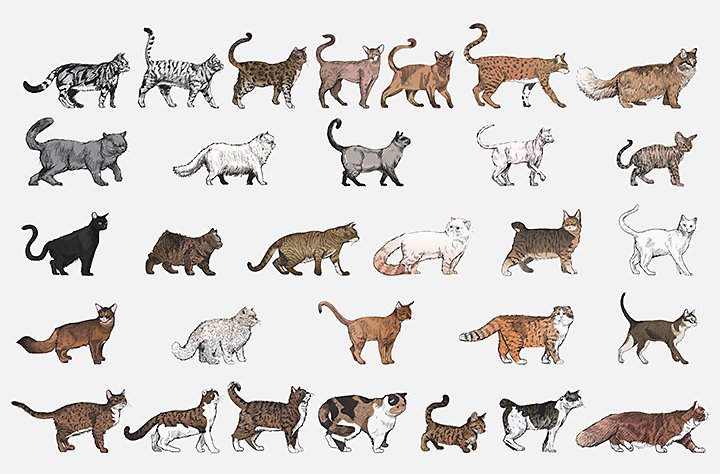
When it comes to cats, there are countless ways to draw them. From hyper-realistic to adorably cartoony, cat drawings of all kinds can express the particular personality of felines. So whether you draw big cats, like a lion or tiger, or a cute house cat, like a tabby or a Persian, these tips will help you capture that cat attitude in your next drawing.
Contributors
ทำสิ่งต่างๆ ได้มากขึ้นด้วย Adobe Illustrator
สร้างโลโก้, ไอคอน, แผนภูมิ, รูปแบบตัวอักษร, ตัวอักษรที่เขียนด้วยมือ และศิลปะเวกเตอร์อื่นๆ
You might also be interested in…
Learn to capture the essence of these beautiful, ferocious big cats.
Take a few shapes to a detailed bunny illustration in Adobe Fresco.
How to draw a dog.
Learn new tricks for creating drawings that capture canine personality and emotion.
Explore the simple beauty of line art drawing.
Learn the basics of line art drawing and build a strong foundation of illustration skills.
